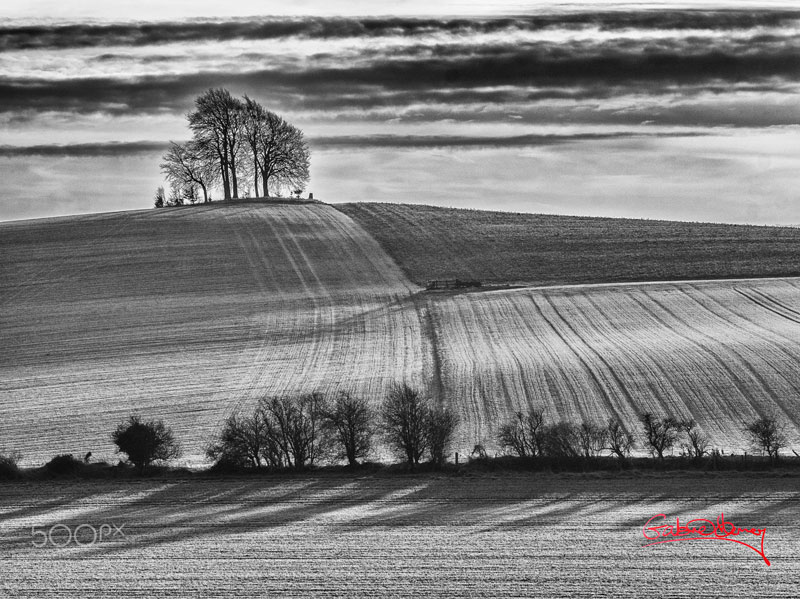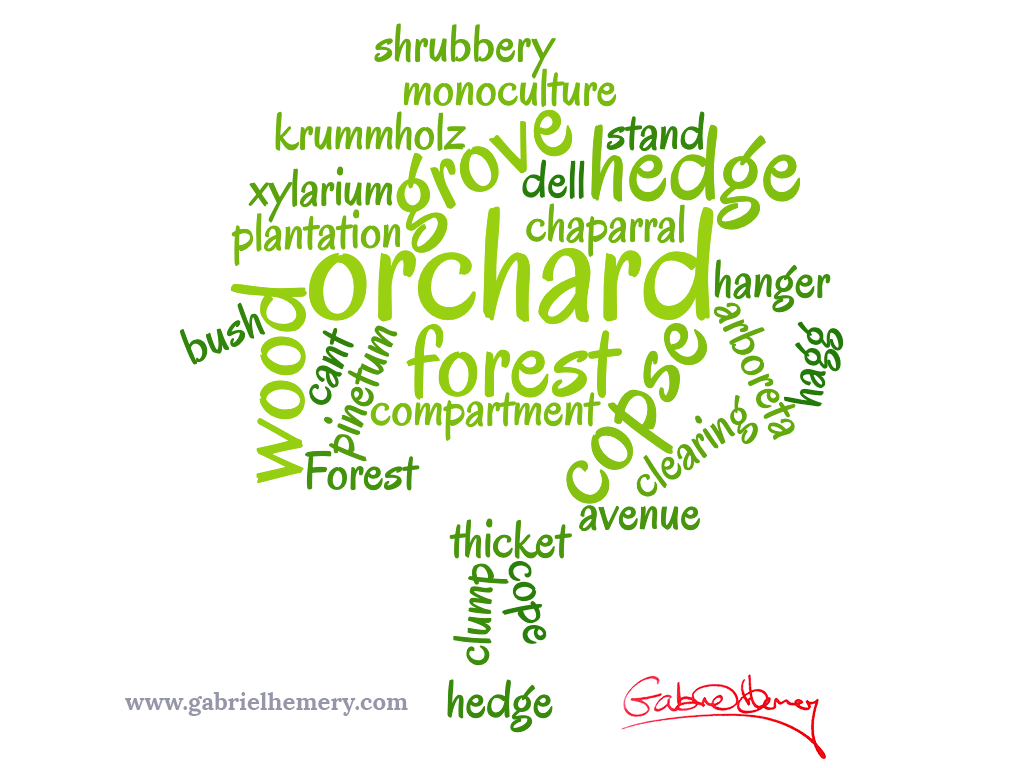When is a forest not a Forest, and a wood not a copse but a spinney? I’ve put together a list of collective nouns for trees from the English language from arboretum to woodland. Perhaps some will be new to you; maybe I’ve missed one that you know.

| collective noun | description |
|---|---|
| arboretum (plural arboreta) | botanical collection of trees, often supporting public education and science activities, including genetic conservation. See list of UK arboreta |
| avenue | row of trees, often a double row, marking an approach to a feature or lining the sides of a road. e.g. lime avenue |
| beare | an old Anglo-Saxon name for a small wood. e.g. Black Tor Beare, Dartmoor |
| bush | wooded area but usually not densely populated with trees |
| cant | block within a woodland (usually 2-5 acres) often used to described an area under coppice management, with the number of cants equal to the rotation length (e.g. with 14 year coppice rotation, there will be 14 cants) |
| chaparral | dense thickets of trees in the Mediterranean region (Europe), California (USA) and Mexico, usually comprising evergreen broadleaved species adapted to hot dry summers |
| clearing | an area clear of trees in a wood or forest, sometimes created when trees are felled for timber or kept free to enhance biodiversity or landscape |
| clump | hilltop group of trees, often prominent in the landscape |
| compartment | management unit of a forest, used as a technical term among foresters to define areas under similar management or with discrete mixtures of tree species |
| coupe | an area within a woodland where the trees are to be felled |
| coppice | refers to the management practice of coppicing, although sometimes used to describe an area managed as a coppice crop e.g. sweet chestnut coppice |
| copse | technically an area managed as coppice but commonly used to describe a small wood. e.g. Piles Copse |
| dell | small valley or hollow, usually ( but not always) covered with trees |
| dingle | steep-sided wooded valley, commonly used in Wales |
| forest or Forest | With a capital ‘F’ refers historically to a royal hunting forest (e.g. Forest of Dean, New Forest), but in modern usage with a lowercase used widely describe a large area of trees, although often interchangeably with wood or woodland |
| grove | a small group of trees, generally of an attractive nature |
| hagg | a clearing in a wood or forest, from Old Norse and used still in northern England |
| hanger | small group of trees on a hillside or slope |
| hedge or hedgerow | a line of trees, often comprising shrub species, traditionally planted and maintained to mark a boundary or to contain livestock. In some part of Britain (e.g. Devon) they are planted on top of soil-filled double stone walls. Traditionally managed by laying, and sometimes with occasional large trees left uncut to grow as ‘standards’ |
| holt | a wooded hill |
| krummholz | trees growing at high latitudes and in exposed situations where their growth is stunted by extreme cold and wind, creating dwarfed and contorted forms |
| monoculture | a group of trees consisting of a single species (e.g. in a plantation) or genetic similarity (e.g. a natural group of clonal aspen grown from suckers) |
| orchard | an area of trees planted and managed for their crop of fruit or nuts, typically using specific varieties to improve food quality and volume production |
| pinetum | a collection of pine (Pinus spp.) trees or more often conifers generally, forming a special type of arboretum |
| plantation | an area of trees deliberately planted by man as a forest operation, typically for timber production although not exclusively |
| Quercetum | a collection of oak (Quercus spp.) trees forming a special type of arboretum |
| roundel | a small group of trees circular in shape (cf. clump) |
| shelterbelt | a band of trees planted or managed to protect soil, crops, and livestock from damaging winds |
| shrubbery | an area of small trees (shrubs) in a garden |
| spinney | a small area of trees, like a copse or wood but traditionally created and managed for hunting game |
| stand | a forestry term used to describe an area of a forest with uniform tree species, structure, age, size etc., similar to a compartment |
| thicket | a dense area of trees, often impenetrable to people |
| withy | a group of willows, often in a damp or boggy area |
| wood or woodland | both terms are used interchangeably, see also forest |
| xylarium | This doesn’t belong here but I like the term! It refers to a collection of woody specimens, as a ‘herbarium’ is for plants. |

Have I missed any terms for groups of trees?
Please add comments below and I will update the list. Thanks
 This work is licensed under a Creative Commons Attribution- NonCommercial- NoDerivs 3.0 United States License.
This work is licensed under a Creative Commons Attribution- NonCommercial- NoDerivs 3.0 United States License.

Has anybody mentioned a shaw? Wiki says “A shaw is a strip of woodland usually between 5 and 15 metres (15 and 50 feet) wide.
Shaws commonly form boundaries between fields or line a road. They are usually composed of natural woodland (rather than being a planted avenue) and often have diverse woodland ground vegetation similar to other natural woodlands in the area. They should not be confused with hedges, even when these are made of mature trees.”
There’s one in Hutton in Essex – Arnold’s Shaw – which fits the description pretty well.
Thanks and well done with the list 🙂
Since childhood I have used the word stemble for a collection of hazel trees. I have not found any reference to this word online have you heard a term it might be a misspelling of. I lived in Germany where I learned some German and Dutch then Norfolk, Lincolnshire, Yorkshire and Suffolk if that might point to a dialect of foreign term.
That’s a new one for me, David. Perhaps some other readers of this site will know …
What about the collective noun for walnut trees? Orange grove, apple orchard, walnut…….
Good to see “stand” in your list. It’s a term I’ve always used but few people recognize now. My mother ( from Oxfordshire, Northamptonshire farming family) used it to describe any discrete group of a single species i.e a homogeneous clump. For example, a ” stand of elms beyond the church”
Thanks for your comment Stuart. You are right of course. While foresters may talk about a stand trees, it also entered more common parlance although it’s perhaps waning now.
A group of Cypress trees grow in sun tropical wetland areas in the shape of a dome. The tallest being the oldest are in the middle, and the trees surrounding them being younger and smaller outward in succession. This is referred to as a cypress dome, or a dome of cypress. Some cedars (which are related to cypress) also grow in this way: A dome of cedar.
*sub-tropics, not sun/ tropics.
Hello I’m Annette and I was looking for names of tree groupings for a story and your name came up in my search. Thank you for the list. Impressive. Maybe at some point
Me, too! It’s nice to encounter other authors in research mode. 🖖🏻
Hi Gabriell, my son Matthew is in the process of repurposing old timber. Using traditional methods creating beautiful household items.. He is setting his business up using the name Mellow Beare. Do you think that this name suits the elegance of old wood ? Thank you Denise
Sounds delightful to me!
Roundel a circular planting of trees often running in pairs, parallel to, but outside an Avenue.
Has anyone heard of a bobblestock of oak ? I queried a customers house name ‘Bobblestock’ and was informed the collective noun for a group of oak
Hi Gabriel,
You have Hedge(row) and Avenue, but not ‘Line’ or ‘Wood Pasture’
I believe a Pinetum is a collection of conifers not just pines. How about Closed Forest – at least 80% canopy cover – versus Open Forest – between 10 and 30% canopy cover. Then there are Parks and other Wood Pastures. We are doing work exploring the Standards in local hedgerows, by the way, in much of Devon the bank is the hedge, anything planted on top is a bonus. In windy areas, Shelter Belts are common. Veteran Trees deserve a mention, especially if they are in what is left of the Wildwood.
I can recommend the Royal Forestry Society’s Glossary of Tree Terms.